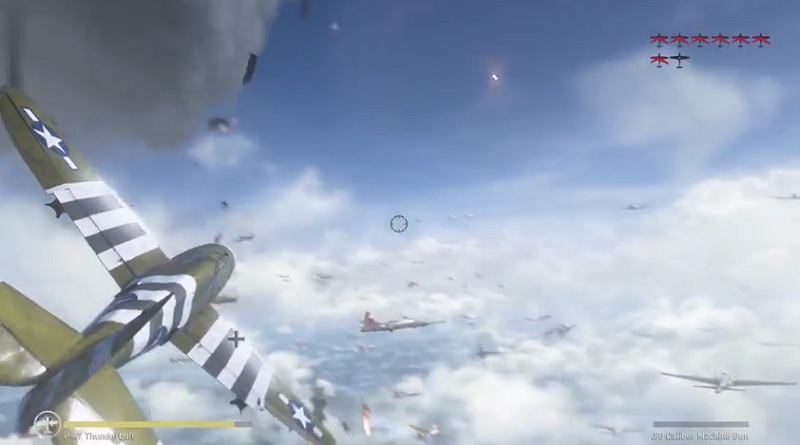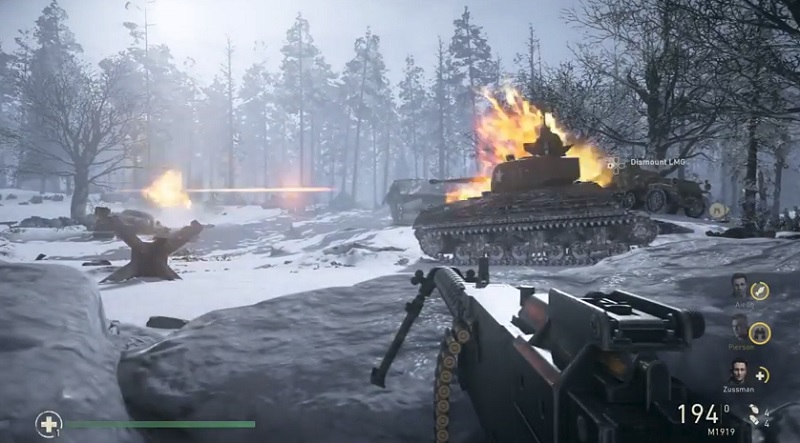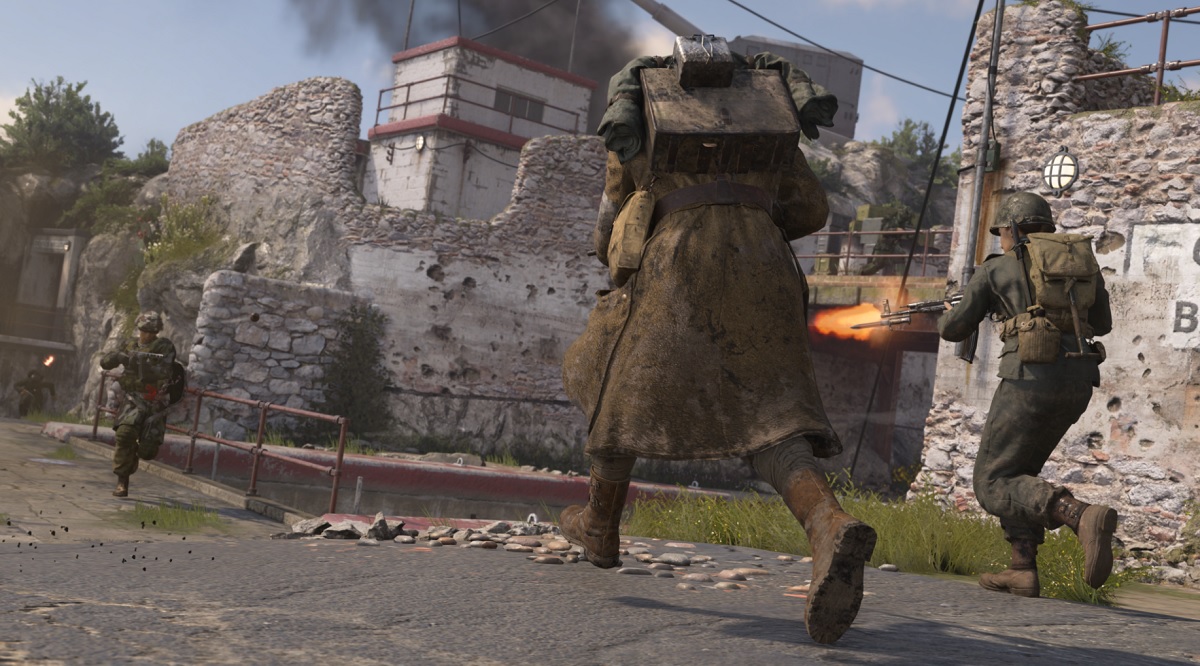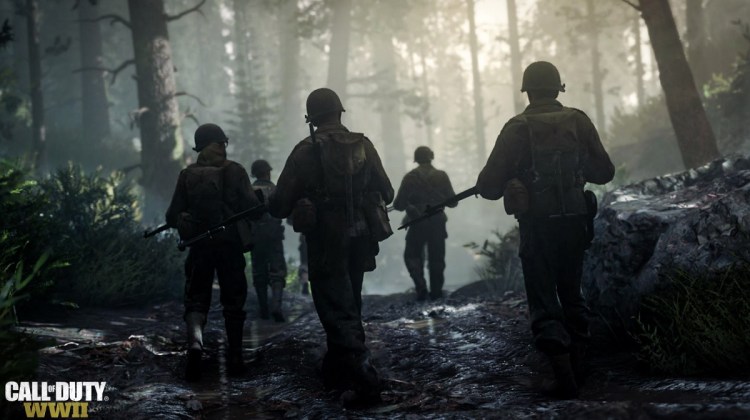
Above: The landing at Omaha Beach in Call of Duty: WWII.
GamesBeat: The enemy isn’t entirely demonized, though, not to the usual video game extreme.
Condrey: It’s true. It’s easy to demonize the Nazis. It’s like you say about the best and the worst of humanity. There were plenty of German soldiers fighting in what they thought was a patriotic cause, who weren’t Nazis. I’m sure you’ve heard stories of soldiers meeting in town on Christmas and sharing a meal together. There are examples of the best of humanity on both sides. We didn’t want to paint every Axis soldier as a Nazi. That wouldn’t have been right either. But I don’t think we held back on showcasing how evil the Nazi state of mind was.
GamesBeat: I feel like the tone changes as you go to multiplayer. It feels different. That’s almost always the case with a Call of Duty game. The interesting thing to me was when I first went into Headquarters. You’re greeted by someone and he talks about your career. I’m going to have a multiplayer career. I’m going to climb up the ladder and see if I can get to prestige. It’s not as much about immersion in history.
Condrey: All three modes of the game, while living in a holistic WWII wrapper, each try to deliver something unique. In the campaign, we’re committed to this rich emotional narrative, an authentic story. Multiplayer has a different goal. And certainly Nazi Zombies is way off in this fantastical story, which we love.
June 5th: The AI Audit in NYC
Join us next week in NYC to engage with top executive leaders, delving into strategies for auditing AI models to ensure fairness, optimal performance, and ethical compliance across diverse organizations. Secure your attendance for this exclusive invite-only event.
Multiplayer is social. We wanted to capture some of the feeling of the gritty, brutal experience. I think you see that in the core combat — the iconic locations, the arsenal of weapons. You see death and destruction. There’s a grittiness to our multiplayer that we didn’t have in Advanced Warfare. But certainly multiplayer is not intended to be historically accurate as far as narrative.
It’s as competitive and social as much as it’s anything. We know that half the time when you play multiplayer you’re going to be thrown on the Axis side. That suspension of the war—the setting is really immersive. The backdrops feel as immersive as the campaign. But the factions, while you’re playing Axis or Allied, are meant to be you in the war.

Above: It’s not all boots on the ground in Call of Duty: WWII.
GamesBeat: The player is still immersed, but they’re immersed in something different.
Condrey: In a similar way, Nazi Zombies is a great story. We loved telling it. As you can imagine, because you’re well-versed in the franchise, there’s nothing authentic about Nazi Zombies. It’s a story about the Monuments Men looking for stolen art and finding something very different. But it’s allowed to express that in a completely different way.
GamesBeat: It seems like this is the way you’re at the most creative. You’re constructing something that doesn’t have to follow any historical guidelines.
Condrey: It’s the most unrestrained as far as our ability to be fantastical, if you will. I don’t know if it’s the right word to describe it. But I love the overarching story of, the Monuments Men go to Germany to find stolen art and they find the Nazis raising an army of the dead instead. And then from there, what does that mean? Well, it means whatever you can imagine. It feels right, because we’re not trying to make it about the history of the war.
But yes, you’re right. Each mode has certain things it brings that marry well to what we’re trying to accomplish. Multiplayer isn’t about the authenticity that campaign has, even though it’s authentic and believable in many ways.
GamesBeat: In that sense, maybe people who are looking the game should understand the context behind each part of it? You can’t really criticize multiplayer on its historical accuracy.
Condrey: Certainly not. And hopefully people are familiar enough with Call of Duty to get that. The construct of the experience is — it’s meant to be fun and vast and engaging and social and competitive and all these things, but by nature—we have disembodied score streaks. We have life respawns. There’s a bunch of stuff that’s been gamified for the experience. I would no more want people to play Nazi Zombies and think we’re trying to be historically accurate than play multiplayer and want to debate why infantrymen on the ground can all of a sudden control a turret gunner with a scorestreak.
But within that, I think what fans love about it—I think it does a good job of putting the player in this gritty war environment. The set pieces themselves are driven from a very believable and authentic sense. Every map you’ve seen is a place we went to.

Above: The Battle of the Bulge in Call of Duty: WWII.
GamesBeat: It seems like there might be a bit of a common thread in — going back to WWII slows the action down. It’s not jumping across the map. You have limitations again. If you see something in the distance you have to run there. Going from WWII to science fiction sped the game up enormously, and now you’re back to a slower pacing.
Condrey: I think that pace really adds to our experience. It adds strategy. You feel like you understand your threats and threat lanes. You feel like you’re able to master the setup that’s to come. I’m proud of what we did on Advanced Warfare, but I haven’t used a sniper rifle in multiplayer in three years. It was just too fast for me. Maybe I’m old. Maybe all of the thrust and boost movement — I wasn’t able to get up to the speed I needed to be at to feel competitive. But now I feel that again, and it’s great, that return-to-the-roots experience. It feels right for this game.
GamesBeat: Plenty of things in here are satisfying for a gamer like me. Do you think this game still has enough for the expert gamer?
Condrey: Absolutely. One thing we always talk about is this idea of “easy to pick up and hard to master.” On Advanced Warfare, maybe we moved away from the “easy to pick up” part and made it harder to master. In this game we have a rich progression. We have weapon progression, division progression, player progression. You have some really unique and interesting multiplayer experiences, like War mode. In Headquarters you want to be the best of the best on the firing range.
I have no doubt that we have avenues for people who are looking to showcase that they’re the most proficient, most skilled. They’ll absolutely find that. We have Raymond Lussier on our team, an ex-champion in Call of Duty esports. He still amazes me with how he can learn to be the best of the best in these games. There’s no slowing down for him. He’s always looking for that edge. So yeah, absolutely. For newcomers, for mid-core guys like you and I — we’ve played a lot, but we’ll never be esports competitors — I think you’ll find all of those.
GamesBeat: Some of the most fun I’ve had is in War mode. It’s an interesting change.
Condrey: What I love about War — when we first prototyped that, we were trying to address this idea that, over the years, Call of Duty multiplayer had become about a lone wolf experience. Even in objective modes that were supposed to be team-based, you weren’t really playing the objectives that much. It was about your K/D. Then you realized that at the heart of your experience, the K/D is the reason. People optimize for the highest K/D, and by extension for bragging rights and the ability to get high-end scorestreaks and all that.
It’s coming back to this idea that it’s about the squad, the greater good of the squad. We wanted to offer a mode that felt like a big war, that felt like you were a critical part of the squad. The first thing we did was remove K/D as a thing you really cared about. Then we prototyped modes that would continue to reinforce this idea that you have to survive and work together on these really critical objectives. I think you feel it now. It’s frenetic and fun, it feels like big action, but it reinforces this idea that—if you play the lone wolf in War you’re not going to do very well, and your team’s not going to do well.
Of course, it has these high drama points. You’re never really out of the fight. The last 10 seconds, right? Have you ever gone into overtime?

Above: The Sledgehammer team visited Gibraltar to get the layout right.
GamesBeat: When you’re not into overtime but just at the end of the bridge in the snowy one.
Condrey: Yeah, that one’s great. Same thing with Breakout. I’ve been at 98 percent and it goes to overtime and you’re getting that last tug of war—I’ve been on both sides. We finally got it over, or they stopped us at two percent short. It’s dramatic and it’s fun.
We’re enjoying War, and we have a lot to offer in November. Those three modes are really compelling. They’re rich in terms of what they offer. Of course, if fans respond the way we expect, we’ll bring more to War mode in the months ahead. We have the competitive modes that people love – TDM, Domination, Hardpoint, Gridiron, those are all great. Headquarters hopefully transforms the social space. There’s a lot there.
GamesBeat: I liked the maps where I figured out something to do, a role for myself. What’s the Battle of the Bulge one called?
Condrey: It’s called Operation Griffin.
GamesBeat: I liked that because just manning the machine gun and standing guard is something you can do. Anyone that comes into view, shoot them.
Condrey: There’s a strategy of knowing — okay, you get the high ground with the machine gun, and then you have two people going left. We’re watching how people are going to implement different strategies there. It’s fun to be able to grab that one place where you can really make a difference, as opposed to just being cannon fodder.
GamesBeat: The building-the-bridge one, too, I would go off to the left and shoot at the guys who were sniping down toward the bridge. I figured out that my light machine gun could shoot through the walls at them.
Condrey: That was an important component in War, giving everybody a role. Guaranteed, when you were back there in that machine gun nest, you were helping your team be successful. If everyone was just optimized for their own K/D and running around, you’re not going to be successful in War mode.
Call of Duty: WWII is available on November 3 for the PC, Xbox One, and Playstation 4. The publisher provided GamesBeat with a copy of PS4 edition of the game for this review, and I attended a review event.


